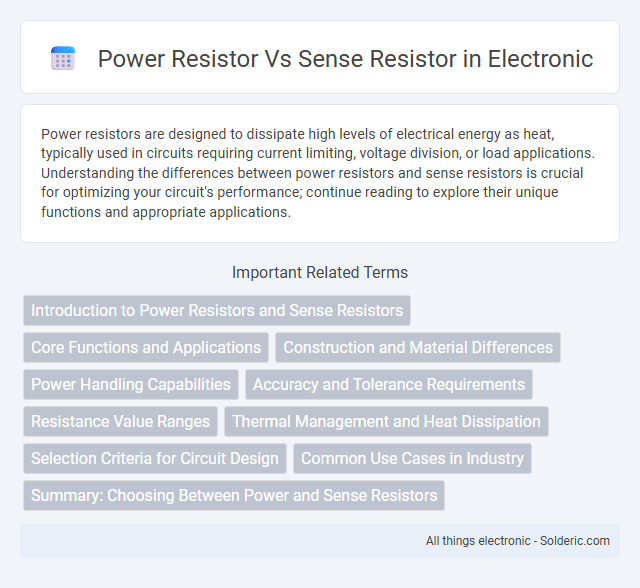Power resistors are designed to dissipate high levels of electrical energy as heat, typically used in circuits requiring current limiting, voltage division, or load applications. Understanding the differences between power resistors and sense resistors is crucial for optimizing your circuit's performance; continue reading to explore their unique functions and appropriate applications.
Comparison Table
| Feature | Power Resistor | Sense Resistor |
|---|---|---|
| Primary Function | Dissipate high power as heat | Measure current by voltage drop |
| Power Rating | Typically 1W to 100W or more | Usually low power, < 1W |
| Resistance Value | Wide range, often higher resistance | Very low resistance, often milliohms |
| Accuracy | General purpose, moderate accuracy | High accuracy, low tolerance |
| Construction | Robust, heat-tolerant materials | Precision materials with minimal temperature drift |
| Typical Applications | Load elements, power dissipation, voltage division | Current sensing in power supplies, motor controllers, battery management |
| Price | Lower cost per unit | Higher cost due to precision requirements |
Introduction to Power Resistors and Sense Resistors
Power resistors are designed to handle high energy dissipation in circuits, typically used to manage current flow and protect components from overheating. Sense resistors, on the other hand, are precision resistors with low resistance values, used primarily to measure current by detecting voltage drop. Your choice between power and sense resistors depends on whether you need to control power dissipation or accurately monitor current.
Core Functions and Applications
Power resistors primarily manage high electrical loads by dissipating significant heat in circuits such as power supplies, amplifiers, and motor controls, ensuring system reliability under heavy current conditions. Sense resistors are designed for precise current measurement in low-resistance, high-accuracy applications like battery management systems, current sensing in DC-DC converters, and feedback loops in power electronics. Their core functions differ with power resistors prioritizing energy dissipation and durability, while sense resistors focus on minimal resistance and accurate signal detection.
Construction and Material Differences
Power resistors are typically constructed with robust materials such as metal oxide or wire-wound elements to handle high wattage and dissipate heat efficiently, often encased in ceramic or metal housings. Sense resistors use thin-film or metal foil materials, designed for precision and low resistance values, enabling accurate current measurements with minimal power loss. Your choice depends on whether you prioritize thermal durability in power resistors or high accuracy and low power dissipation in sense resistors.
Power Handling Capabilities
Power resistors are designed to handle high power dissipation, often ranging from several watts to hundreds of watts, making them suitable for applications requiring significant energy dissipation. Sense resistors, on the other hand, are optimized for precise low-resistance measurements and typically have lower power ratings, usually under one watt, to minimize heat generation and measurement inaccuracies. Your choice between power and sense resistors depends largely on the required power handling capacity and accuracy in your circuit design.
Accuracy and Tolerance Requirements
Power resistors generally have lower accuracy and wider tolerance ranges, often between +-5% to +-10%, as they primarily dissipate energy rather than provide precise measurements. Sense resistors require high accuracy and tight tolerances, typically +-0.1% to +-1%, to ensure precise current sensing and measurement in circuits. Selecting the correct tolerance level is critical for maintaining measurement reliability and system performance in sensing applications.
Resistance Value Ranges
Power resistors typically have resistance values ranging from milliohms to several kilo-ohms, designed to handle high power dissipation in circuits such as voltage regulation and current limiting. Sense resistors feature much lower resistance values, often in the micro-ohm to milliohm range, to provide precise current measurement with minimal voltage drop and power loss. Your choice between these two depends on the required resistance range and power handling capability for the specific application.
Thermal Management and Heat Dissipation
Power resistors are designed to handle high power loads with robust thermal management features such as larger surface areas, heat sinks, and materials with high thermal conductivity to efficiently dissipate heat. Sense resistors typically operate at low power levels and generate minimal heat, often requiring less complex thermal management but must maintain accuracy despite temperature changes. Your choice between power and sense resistors should consider the thermal load and heat dissipation needs to ensure reliable and stable circuit performance.
Selection Criteria for Circuit Design
Power resistor selection in circuit design prioritizes high power dissipation capability and thermal stability to handle significant current loads and prevent overheating. Sense resistors require extremely low resistance values with tight tolerance and minimal temperature coefficient to ensure accurate current measurement without affecting circuit performance. Both types must consider resistance value, power rating, tolerance, and temperature coefficient, but power resistors emphasize durability under load, while sense resistors focus on precision and minimal intrusion.
Common Use Cases in Industry
Power resistors are commonly used in applications requiring high power dissipation, such as motor controls, power supplies, and load testing equipment, where managing large currents safely is critical. Sense resistors are primarily used in precise current measurement scenarios within battery management systems, power converters, and amplification circuits, providing accurate feedback for control signals. Your choice between these resistors depends on whether you need robust power handling or high-precision current sensing.
Summary: Choosing Between Power and Sense Resistors
Power resistors are designed to handle high power dissipation and manage significant heat generated in electrical circuits, making them ideal for controlling current in high-load applications. Sense resistors are characterized by their low resistance and precision, primarily used for accurate current measurement and feedback in control systems. Your choice depends on whether the priority is energy dissipation or precise current sensing within the circuit.
Power resistor vs sense resistor Infographic

 solderic.com
solderic.com